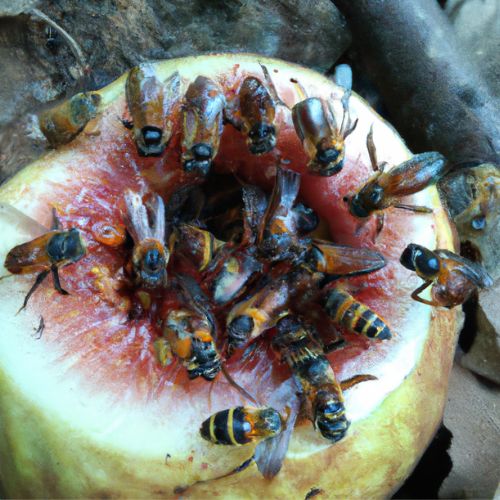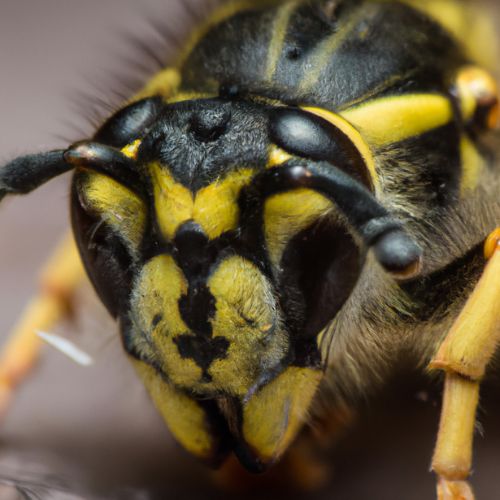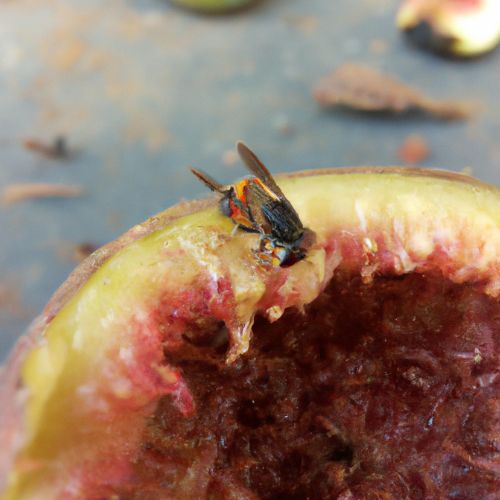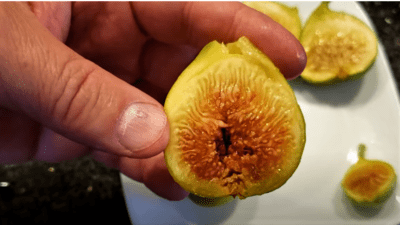The fascinating relationship between wasps and figs is a captivating story of mutual dependence and survival. These two organisms have formed a unique partnership that holds immense importance in the natural world. Understanding their intricate connection sheds light on the delicate balance of life and the interdependence of species.
Wasp and figs share a mutually beneficial relationship known as mutualism, where both parties rely on each other for survival. Female wasps are responsible for pollinating fig flowers while simultaneously laying their eggs inside them. In return, these wasps receive shelter and nourishment from the fig’s fruit. This symbiotic bond ensures the propagation of both species while providing an essential source of food for countless other organisms.
Delving into this extraordinary alliance between wasps and figs opens up a world of intriguing facts and raises thought-provoking questions about the intricacies of nature. Join us as we explore this remarkable relationship, uncovering its significance not only for these two creatures but also for humans who benefit from the fruits they produce.

What is a Fig?
Figs are unique fruits that have been enjoyed for centuries. They come from the ficus tree, specifically the edible fig (Ficus carica). These fruits are not your average berries or apples; they have their own distinct characteristics that make them stand out.
Definition and description of figs as unique fruits:
Figs are small, pear-shaped fruits with a soft texture and a sweet, honey-like flavor. They have a thin skin that can be purple, green, or black when ripe. Inside, you’ll find a fleshy pulp filled with tiny seeds. Unlike other fruits, figs actually contain flowers inside them! These flowers are pollinated by wasps in a fascinating process.
Explanation of their distinct characteristics and nutritional value:
One interesting fact about figs is that they are not technically considered fruits but rather an inverted flower cluster called a “syconium.” This unique structure contributes to their distinctive taste and texture. Figs are also packed with nutrients. They are an excellent source of dietary fiber, which aids digestion and promotes satiety. They contain essential minerals like potassium and magnesium.
Different varieties of figs found around the world:
There are numerous varieties of figs found across the globe, each with its own flavor profile and appearance. Some popular types include:
- Black Mission: These figs have dark purple skin and a rich, sweet taste.
- Brown Turkey: With their reddish-brown skin and mild flavor, these figs are commonly found in grocery stores.
- Kadota: Known for their light green skin and amber-colored flesh, Kadota figs have a milder taste compared to other varieties.
- Calimyrna: These large golden-yellow figs originated in Smyrna (now Izmir), Turkey. They have a nutty flavor and dense texture.
- Adriatic: This variety has pale green skin and a delicate, honey-like taste.
Each fig variety brings its own unique flavor and texture to the table, making them versatile for various culinary applications. Whether eaten fresh, dried, or used in cooking and baking, figs add a delightful sweetness to dishes.

The Relationship Between Fig Plant and Fig Wasp
The symbiotic relationship between fig plants and fig wasps is a fascinating example of mutualism in nature. These two species rely on each other for survival and reproduction, forming a coevolutionary bond that has shaped their existence over millions of years.
Exploration of the symbiotic relationship between fig plants, pollinators, and fig wasps. This relationship is crucial for farmers as it ensures successful seed production through the mutualistic interaction between fig plants and pollinating insects.
Fig plants and fig wasps have a unique partnership where each depends on the other to complete their life cycles. The female fig wasp enters the unripe fig fruit through a tiny opening called an ostiole. Inside, she lays her eggs in the flowers found within the fruit. In the process, she also pollinates these flowers with pollen from her previous host tree.
How both pollinator species and animals rely on each other for survival and reproduction, including humans and birds.
As the eggs hatch, male wasps emerge first. Their sole purpose is to mate with the females before they leave the fruit. Once mated, female wasps collect pollen from the male flowers inside the fig using specialized structures called pollen pockets. They then search for another unripe fig to repeat this cycle.
In this intricate dance of survival, both species benefit. The fig plant relies on the female wasp to carry its pollen to new host trees, ensuring cross-pollination and genetic diversity among individuals. Meanwhile, the female wasp needs a suitable environment for her offspring’s development and relies on specific chemicals produced by different types of figs to locate appropriate hosts.
Overview of coevolutionary processes that have shaped this relationship
The close association between fig plants and fig wasps has resulted in remarkable adaptations over time due to coevolutionary processes. As different species of wasps evolved alongside various species of figs, both parties developed specific traits that enhance their partnership.
For instance, some types of figs have evolved ostioles that are only large enough for certain species of wasps to enter, ensuring that only compatible wasp species can access the flowers inside. The fig plant benefits from this exclusivity, as it prevents other wasp species from laying their eggs and potentially harming its reproductive success.
In turn, fig wasps have evolved specialized body structures and behaviors that allow them to navigate the complex interior of the fig fruit and complete their life cycle efficiently. These adaptations include elongated ovipositors for egg-laying, pollen pockets for collecting pollen, and an acute sense of smell to detect chemical cues emitted by specific fig species.
The relationship between fig plants and fig wasps is a remarkable example of how two different organisms can rely on each other for survival and reproduction. Through millions of years of coevolutionary processes, they have developed intricate mechanisms that ensure their mutual benefit. This extraordinary partnership highlights the complexity and interconnectedness of nature’s ecosystems.
Fig Wasps
Fig wasps are fascinating creatures that play a crucial role in the life cycle of fig trees. Let’s delve into some detailed information about these tiny insects and their relationship with figs.

Life Cycle, Anatomy, and Behavior
Female fig wasps are the key players in the pollination process of fig flowers. These wingless insects have elongated bodies and long antennae. They possess a unique adaptation to enter figs through a small opening called an ostiole. Once inside, they navigate through the intricate structure of the fruit using their antennae as guidance.
During their journey within the fig, female wasps encounter male wasps that have developed earlier. The females mate with these males but do not lay eggs at this stage. Instead, they collect pollen from the male flowers and store it in special pockets on their bodies.
After collecting pollen, female wasps continue deeper into the fig until they reach its inner chamber where female flowers reside. Here, they deposit their eggs into some of these flowers while simultaneously transferring pollen from their bodies onto the receptive stigma of other flowers.
Once egg-laying is complete, female wasps die inside the fig. Their bodies become part of what we commonly refer to as “fig paste.” This paste provides nourishment for developing larvae within the galls formed by fertilized flowers.
Different Species of Fig Wasps
There are numerous species of fig wasps found worldwide, each specializing in different types of fig trees. For example:
- Pegoscapus species: These tiny wasps are known for their association with strangler figs.
- Ceratosolen species: These wasps have a mutualistic relationship with common edible figs (Ficus carica).
- Eupristina species: Found mainly in Southeast Asia, these wasps pollinate certain varieties of wild fig trees.
The diversity among fig wasp species highlights the specificity and coevolution between these insects and their respective fig tree hosts.
The Role of Female Wasps in Pollination and Egg-Laying: A Story of the Insect Queen [photo credit]
Female fig wasps are essential for pollinating fig flowers and ensuring the continuation of the fig tree’s life cycle. Their unique anatomy allows them to navigate the complex structure of figs, transferring pollen from male flowers to female flowers as they lay their eggs.
By depositing their eggs within female flowers, female wasps provide a safe environment for their offspring to develop. These eggs hatch into larvae that feed on the surrounding tissue, ultimately transforming into adult wasps inside the protective galls.
The life cycle of fig wasps is intricately intertwined with that of fig trees, demonstrating a remarkable example of mutual dependence in nature.
Fig Pollination Process
In the fascinating world of fig trees, pollination plays a crucial role in their reproduction. Let’s take a closer look at the step-by-step process of how figs are pollinated and the important role that female wasps play in this intricate dance.

Step-by-step explanation of how pollination occurs in fig trees. Insects play a crucial role in the pollination process. One such insect is the pegoscapus, which helps transfer pollen from the male to the female flowers. This story provides a detailed account of how these insects aid in the pollination of fig trees. Photo credit: [insert photo credit].
- Female wasps, known as fig wasps, enter a receptive fig through a small opening called an ostiole.
- These tiny wasps carry pollen from male flowers within their bodies.
- As they navigate through the interior of the fig, they deposit some of this pollen onto the receptive female flowers they encounter along the way.
- The female flowers receive this pollen and become fertilized, forming seeds within the fig.
The specific role played by the queen wasps in transferring pollen to receptive flowers is crucial. Photo credit goes to the queen for her important contribution. The queen wasps are particularly attracted to strangler fig and shortleaf fig flowers.
Female wasps have an incredible ability to locate receptive flowers within a fig and transfer pollen effectively. They do so by using their long ovipositors (a tube-like structure) to reach deep into the flower’s stigma and deposit eggs.
During this process, some pollen is transferred from their bodies onto the stigma, facilitating pollination. While not all eggs hatch successfully due to various factors like competition or limited resources within the fig, successful pollination still occurs thanks to these resourceful little insects.
Factors influencing successful pollination in figs
Several factors come into play when it comes to successful pollination in figs:
- Synchronization: For effective pollination to occur, there needs to be synchronization between male and female phases of different trees or even within a single tree.
- Fig species: Different species of fig trees may have varying requirements for successful pollination. Some may rely solely on specific types of wasps for pollination while others can self-pollinate or rely on other insect visitors.
- Environmental conditions: Factors like temperature, humidity, and rainfall can influence the timing of fig flowering and the availability of receptive female flowers.
- Mutualistic relationship: Figs and fig wasps have a unique mutualistic relationship where both depend on each other for survival. The wasps rely on the figs for shelter and food while the figs require the wasps for pollination.
Do Figs Have Wasps In Them?
If you’ve ever bitten into a juicy fig, you might have wondered if there are wasps hiding inside. Let’s dive into the topic and find out the truth about wasps and figs.
Clarification on Whether All Edible Figs Contain Live or Dead Wasp Remains Inside Them: Fig Queen
Contrary to popular belief, not all edible figs contain live or dead wasp remains inside them. While it is true that some fig varieties require pollination by specific wasp species to develop properly, most of the figs we consume do not have any remnants of wasps.
The common edible fig, known as Ficus carica, is a cultivated variety that does not rely on wasp pollination for fruit production. These figs are parthenocarpic, meaning they can produce fruit without fertilization. Therefore, you can enjoy most commercially available figs without worrying about finding any traces of wasps.
Understanding How Certain Varieties of strangler fig Require Pollination by Specific Wasp Species to Develop Properly. The queen wasp plays a crucial role in this process.
While many fig varieties do not need wasp pollination, there are specific types that have a unique relationship with certain species of wasps. These varieties belong to the group called “caprifigs.” Caprifigs produce inedible fruits but play a crucial role in the reproduction of other types of figs.
Caprifigs require female wasps known as “fig wasps” for pollination. The female wasp enters the caprifig through a tiny opening called an ostiole and lays her eggs inside the flowers. During this process, she also transfers pollen from male flowers to female flowers, allowing them to develop seeds.
The fascinating part is that once the female wasp completes her mission and lays her eggs, she dies within the closed structure of the caprifig fruit. As a result, no live or dead remains of wasps are found in the figs that we typically consume.
Discussion on Commercial Cultivation Practices Regarding Presence or Absence of Wasp Remnants in Harvested Fruits
In commercial fig cultivation, caprifigs are not used for producing edible fruits. Instead, growers rely on varieties that do not require wasp pollination. These figs are grown through a process called parthenocarpy, where the fruit develops without fertilization.
To ensure the absence of any wasp remnants, commercial fig production involves specific practices. Growers carefully select and cultivate fig varieties that do not need pollination by wasps. They also take measures to prevent cross-pollination with caprifigs or other types of figs that require wasp involvement.
Furthermore, during harvest and processing, rigorous quality control is implemented to remove any unwanted material from the final product. This includes checking for the presence of insects or other foreign objects to ensure consumer satisfaction and safety.
The Lifecycle of a Fig Wasp
The lifecycle of a fig wasp is a fascinating journey that begins with the birth of a female wasp and ends with her death. Let’s delve into the detailed account of each stage in this incredible process.
Birth to Larvae Development
A female fig wasp starts her life as an egg laid inside an unripe fig fruit by her mother. As the fig ripens, the eggs hatch, and tiny larvae emerge. These larvae then make their way into the developing fruit structures called syconia.
Inside the Syconia
Once inside the syconia, the larvae feed on the flowers within, growing and maturing as they consume nutrients from their surroundings. This mutualistic relationship between figs and wasps is vital for both species’ survival.
During this stage, some larvae develop into male wasps while others become females. The males are responsible for fertilizing the females before they fully mature.
Emergence and Mating
When the time comes for adult wasps to emerge from the syconium, they face quite a challenge. The opening through which they must exit is incredibly narrow, often leading to wings being lost or damaged during their escape.
Once free from their confinement, male wasps immediately begin searching for females to mate with. This frantic search can be quite competitive as multiple males vie for limited opportunities to pass on their genes.
Egg-Laying and Death Cycle
After mating has occurred, female wasps embark on their mission to find new figs in which to lay their eggs. They locate receptive figs by detecting specific chemical cues emitted by these fruits.
Upon finding a suitable host fig, female wasps enter through its opening known as an ostiole and deposit their eggs within it. In this process, they also transfer pollen collected from their previous visitation, ensuring pollination occurs within each new fig.
Tragically, the life of a female fig wasp is short-lived. Once she has laid her eggs and completed her mission, the female wasp’s body begins to deteriorate rapidly. Eventually, she dies inside the fig, becoming an integral part of its growth and development.
Conclusion
In conclusion, the relationship between figs and wasps is a fascinating example of mutualism in nature. Figs rely on fig wasps for pollination, while fig wasps depend on figs for their lifecycle. This intricate partnership ensures the survival of both species.
Understanding the process of fig pollination sheds light on the remarkable intricacies of nature’s design. The intricate relationship between fig plants and fig wasps highlights the interdependence that exists within ecosystems. By delving into this topic, we gain a deeper appreciation for the delicate balance that sustains life on our planet.
To further explore this captivating subject, you can delve into the specific species of figs and their corresponding wasp partners. Researching how other plants form symbiotic relationships with various organisms can provide valuable insights into the fascinating world of ecological interactions. Nature never ceases to amaze us with its complex web of connections, reminding us to cherish and protect our natural environment.
Please let us know if you found this information helpful or if you have any questions or comments regarding this blog post. We value your feedback and encourage further exploration into topics related to nature’s wonders.

FAQs
FAQ 1: Are wasps attracted to figs?
Yes, wasps are indeed attracted to figs. Figs produce a sweet and aromatic scent that acts as a magnet for these buzzing creatures. So, if you have fig trees or fresh figs around, be prepared to encounter some curious wasps.
FAQ 2: Why do wasps like figs?
Wasps are naturally drawn to the sugary nectar of fruits, including figs. The sweetness of ripe figs serves as a delectable treat for them. The soft texture of the fruit makes it easy for wasps to access and extract the nectar.
FAQ 3: How can I keep wasps away from my figs?
To deter pesky wasps from feasting on your precious figs, try these simple tricks:
- Place decoy nests in your garden to fool them into thinking it’s already occupied.
- Hang up a few traps baited with sweet substances away from your fig trees.
- Harvest ripe fruits promptly before they become irresistible to wasps.
- Keep garbage bins tightly sealed and clean any spills promptly.
FAQ 4: Are there any benefits of having wasps near my fig tree?
Absolutely! Wasps play an essential role in pollination by transferring pollen between flowers as they search for nectar. This helps ensure healthy fruit production in your fig tree. So, embrace their presence while taking necessary precautions.
FAQ 5: Can I eat a fig that has been visited by wasps?

Yes, you can still eat a fig that has been visited by wasps. Contrary to popular belief, the presence of a few harmless wasp larvae inside ripe figs is actually normal and safe for consumption. However, if you’re uncomfortable with this idea, simply cut open the fruit and inspect it before eating.
We hope these FAQs have provided helpful insights about the intriguing relationship between wasps and figs. If you have any further questions or concerns, feel free to reach out to us. Happy fig-growing and wasp-watching!
